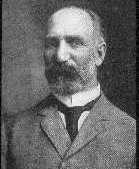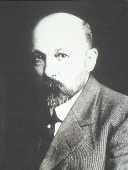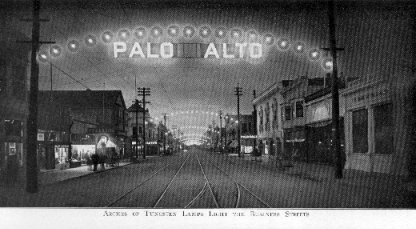| In 1896, Peninsula Lighting Company (PLC) of Redwood City brought electricity to the newly incorporated town of Palo Alto, at a cost of 20 cents per kilowatt-hour. In response to PLC's high prices, two civic-minded Stanford professors who lived in Palo Alto led a campaign to create a city-run electric utility. Dr. Charles "Daddy" Marx, a professor of civil engineering, and Charles B. Wing, a professor of structural engineering, believed that Palo Alto could build and operate its own system for half the PLC rate. As a result of their efforts, the community-owned electric utility in Palo Alto began its operation on January 16, 1900. A town ordinance was passed setting the electric rate at 10 cents per kilowatt-hour, thereby validating the professors' assertions. |  Charles Marx |
 Charles Wing |

 Doll house: Side A-With electricity. Side B-Before electricity.
Which do you pick: Romantic gas and firelight, or all modern conveniences?
Incandescent vs. fluorescent lamp power use:
Which lamp will cost less to operate?
Which will have the least environmental impact?
Did you consider the impact of the manufacturing process?
Fiber optics: Fiber optics are replacing wire for high speed
communication. Each line can carry more information than copper wire
and take less space, are less likely to fail, and are immune to the
effects of solar wind changes.
The Palo Alto Sign: A replica of the lighted arch that hung
over University Avenue from 1911 to 1925. Underneath are samples of
cable and pipe found under the street.
Fire alarm ticker: What we had before 911. Remember those
street corner fire alarm boxes? When you pulled the handle,
a ticker in the fire house printed out a code with the position of
the alarm box, sending the trucks on their way.
Doll house: Side A-With electricity. Side B-Before electricity.
Which do you pick: Romantic gas and firelight, or all modern conveniences?
Incandescent vs. fluorescent lamp power use:
Which lamp will cost less to operate?
Which will have the least environmental impact?
Did you consider the impact of the manufacturing process?
Fiber optics: Fiber optics are replacing wire for high speed
communication. Each line can carry more information than copper wire
and take less space, are less likely to fail, and are immune to the
effects of solar wind changes.
The Palo Alto Sign: A replica of the lighted arch that hung
over University Avenue from 1911 to 1925. Underneath are samples of
cable and pipe found under the street.
Fire alarm ticker: What we had before 911. Remember those
street corner fire alarm boxes? When you pulled the handle,
a ticker in the fire house printed out a code with the position of
the alarm box, sending the trucks on their way.
